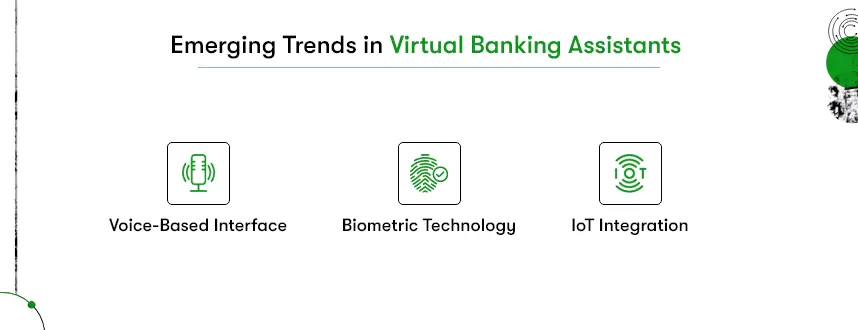Is the Virtual Banking Assistant worth the hype? Why are banks frequently advised to adopt AI-powered virtual assistants?
Over 75% of the U.S. population is currently banking digitally, making the digital experience a priority for banks to maintain a positive customer experience.
When prioritizing a digital banking experience, adopting virtual assistants is a strategic move. Virtual assistants enhance customer engagement, provide personalized services, streamline operations, and ensure round-the-clock support, all of which are key factors in delivering a superior digital banking experience.
Leading banks in the USA have been at the forefront of innovation and leveraging the latest technology, and Virtual Banking Assistants are no exception. For example,
Bank of America has implemented a virtual assistant named Erica, surpassing 1.5 billion client interactions. In addition to being available 24/7, Erica can check balances, notify account changes, and do more for its users.
Wells Fargo has also developed a virtual assistant known as Fargo. Fargo simplifies banking tasks for customers and assists them in managing finances.
Evidently, AI-powered Virtual assistants are reshaping the banking industry, making room for banks to transform how customers interact with their services. This article will explore how these AI-powered entities can address the banking industry’s unique needs.
What is a Virtual Banking Assistant?
Virtual assistants are intelligent computer programs designed to interact with users and provide assistance or information using natural language processing and AI technologies. These digital assistants, also known as chatbots or conversational agents, have witnessed a surge in popularity due to their ability to enhance customer experiences, streamline processes, and increase operational efficiency.
An AI Banking Assistant is a valuable tool. It can interact with customers on your bank’s behalf and assist them with banking-related tasks and inquiries. This way, you can enhance customer engagement, improve operational efficiency, and meet the evolving expectations of modern digital banking. Because it combines AI and natural language processing to provide convenient and personalized banking experiences for customers.
Let’s see a virtual banking assistant’s key features and functions:
Customer Support: Providing instant responses to customer queries about account balances, transaction history, account setup, and general banking information.
Personalization: Analyzing customer data to offer personalized product recommendations, financial advice, or alerts about relevant promotions or updates.
24/7 Availability: Offering round-the-clock support, ensuring customers can access assistance anytime, even outside of regular banking hours.
Transaction Assistance: Assisting with fund transfers, bill payments, setting up recurring payments, and other transaction-related activities.
Security: Implementing advanced security measures like voice recognition, two-factor authentication, or biometric verification to protect customer data and transactions.
Onboarding and Account Management: Guiding new customers through the account setup process and helping them navigate banking services efficiently.
Data Analytics: Collecting and analyzing customer interactions to gain insights into user behavior and preferences, which can inform improvements to services and customer experiences.
Multichannel Integration: Seamlessly integrates with various digital platforms, such as websites, mobile apps, and messaging apps, to provide a consistent experience across channels.
Language Support: Offering multilingual capabilities to cater to a diverse customer base.
What are the benefits of using an AI-powered Virtual Assistant in the Bank?

Using an AI-powered virtual assistant in a bank can bring many benefits beyond enhancing customer engagement and meeting the standards of Digital banking transformation.
AI assistants can empower banks to streamline various aspects of their business, reduce risks, maintain compliance, and make data-driven decisions. Ultimately contributing to better financial performance and customer satisfaction.
Risk Management:
Virtual Assistants can assist in identifying potential risks by monitoring transactions and flagging suspicious activities, helping banks detect fraud and prevent. For example, DBS Bank’s AI virtual assistant monitors customer transactions and flags suspicious activity. This has helped the bank detect and prevent fraud, saving it millions of dollars annually.
Compliance and Regulatory Assistance:
AI virtual assistants can play a vital role in helping banks stay compliant with industry regulations and swiftly adapt to changing regulatory requirements. By providing accurate and up-to-date information, AI virtual assistants can help banks save time and money and reduce the risk of compliance violations.
Market Insights:
Virtual Assistants can analyze customer interactions by gathering and processing data from customer queries, behaviors, and preferences. They can identify trends, customer sentiment, and emerging needs.
This data-driven analysis empowers banks to make informed decisions about product development and market positioning. This way, banks can adapt to evolving customer demands and stay competitive in the financial industry.
Reduced Error Rates:
Virtual bank assistant automation can help banks minimize the likelihood of human errors in data entry, reducing costly mistakes that can impact both customers and the bank. By automating repetitive tasks, validating data, and auditing data, virtual assistants can help banks ensure their data is accurate and complete.
Quick Product and Service Updates:
Banks can use Virtual Assistants by programming them to send customers automated messages, alerts, or notifications via digital channels like mobile apps, websites, or messaging platforms. These messages can provide updates on new products, services, interest rates, or policy changes in real-time, ensuring customers are promptly informed.
Employee Support:
Virtual assistants can be used internally to help bank employees with tasks like retrieving information, conducting training, and handling HR inquiries. This enhances staff efficiency and job satisfaction.
Brand Reputation:
Offering cutting-edge AI-powered services can boost a bank’s reputation as an innovative and customer-focused institution, attracting new customers and retaining existing ones.
Virtual Assistants can collect customer feedback, helping banks understand their needs and preferences and facilitating continuous improvement in service delivery.
Cross-Selling and Upselling:
Virtual Assistants can proactively suggest relevant financial products and services during customer interactions, increasing the chances of additional sales without manual intervention. This smart approach enhances the bank’s cross-selling efforts, ultimately leading to increased revenue and customer satisfaction.
Top Banks in the USA with Virtual Assistants

Meeting instant customer demands and offering efficient support is paramount for banks. A Virtual assistant is another use case of AI in banking that has emerged as a powerful solution to address staffing challenges and deliver round-the-clock support.
1. Erica – Bank of America
Launched in 2018, Erica, Bank of America’s virtual banking assistant, is a cutting-edge AI-driven financial assistant.
- Erica leverages advanced analytics and cognitive messaging to offer Bank of America users personalized guidance.
- Currently available in English, with plans to expand to Spanish.
Key Functions:
- Access routing and account numbers.
- Check balances.
- Find and view Zelle payments.
- Lock/unlock cards and request replacements.
- Receive notifications for duplicate charges and bill reminders.
- Monitor recurring charges and spending trends.
- Access FICO Score Insights.
- Connect with Merrill advisors.
2. Chase Digital Assistant – JP Morgan Chase
Chase’s virtual banking assistant, launched in November 2020, offers essential banking functions.
- Available only in English (potential future expansion).
- To use, sign in to the Chase Mobile app and access the assistant through the chat window.
Key Functions:
- Check account balances.
- Retrieve account or routing numbers.
- Manage credit and debit cards (lock/unlock, replace).
- Transfer money, pay bills, and view investment information.
- Quick app navigation.
3. Eno – Capital One
Capital One introduced Eno, an AI-powered personal finance assistant, in 2017.
- Eno is gender-neutral and conversational, available in mobile apps and browsers.
- Offers notifications via email, text messages, or smartwatch alerts.
- Available 24/7, with shorthand and emoji-based communication.
Key Functions:
- Manage accounts and cards.
- Update personal information.
- Add authorized users.
- Check credit lines and pay bills.
- Entertain with jokes.
4. Ally Assist – Ally Bank
Ally Assist, introduced in 2015, brings AI-powered assistance to Ally Bank customers.
- Allows speech or text interactions for various tasks, including transfers, payments, and deposits.
- Offers detailed account and transaction information and insights into saving/spending patterns.
Key Functions:
- Initiate transfers and payments.
- Access account information and interest earned.
- Query spending with specific merchants.
- Anticipates user needs through data profiles and machine learning.
5. Smart Assistant – U.S. Bank
U.S. Bank launched Smart Assistant during the pandemic to facilitate natural conversations.
- Offers voice-first interaction for an authentic banking experience.
- Supports complex tasks, recognizing account nicknames.
Key Functions:
- Enroll with Zelle.
- Pay bills.
- Manage rewards and locate ATMs/branches.
- Deposit checks.
- Update contact information and manage cards.

How do you develop an efficient Virtual Assistant for your bank?
You can ask your developers to create a Virtual Assistant during banking app development or build separately. In any case, following the below steps will help you strategize your banking virtual assistant development efficiently.
Identifying business requirements and objectives
Before implementing a virtual assistant solution, you must identify your bank’s specific business requirements and objectives. Determine the key tasks the virtual assistant should handle, understand your target audience and their preferences, and outline the desired outcomes from implementing the solution. By aligning your virtual assistant with your goals, you set the stage for success.
Types of Virtual Banking Assistants
Consider the type of virtual banking assistant that best suits your needs. Choosing the right type is essential for meeting your banking objectives and customer expectations. Here are some common VBA types to choose from:
- Customer Service Chatbots: These AI-powered chatbots handle customer inquiries, provide information, and assist with basic transactions.
- Voice-Activated Assistants: These assistants respond to voice commands, making them suitable for hands-free interactions.
- Personal Finance Assistants: These assistants offer customers financial guidance, budgeting, and personalized recommendations.
- Transaction Assistants: These assistants facilitate banking transactions such as fund transfers, bill payments, and account management.
- Investment and Wealth Management Assistants: Designed for investment-related queries, they offer advice on portfolio management and financial planning.
- Security Assistants: Focused on account security, they assist with setting up security features and reporting suspicious activities.
- Loan and Mortgage Assistants: These specialized assistants guide customers through loan and mortgage applications.
- Data Analytics Assistants: These assistants analyze financial data to provide insights and assist with decision-making.
- Compliance Assistants: Designed to ensure regulatory compliance, they monitor transactions and flag potential issues.
- Personalized Marketing Assistants: These assistants deliver tailored marketing messages and promotions to customers.
Evaluating features and capabilities
Once you’ve outlined your objectives and selected the type of virtual assistant, it’s time to evaluate the features and capabilities of different virtual assistant solutions. This assessment should include factors like natural language processing, integration capabilities, analytics and reporting functionalities, scalability, and customization options.
By carefully comparing the offerings of various vendors, banks can make an informed decision about which solution aligns best with their requirements.
Choosing the Right Technology for AI-Based Virtual Banking Assistants
When it comes to developing an AI-powered virtual banking assistant (VBA), it’s essential to choose the right technology stack. The technology stack should support the complex AI and NLP (Natural Language Processing) functionalities required for VBAs while ensuring seamless integration across various channels.
Technologies like Python and Node.js are often used for the core AI and NLP components of VBAs. In contrast, Flutter, primarily known for cross-platform app development, can also play a valuable role in VBA implementation. Here’s how;
- Multi-Channel Support: Enables VBAs on mobile, web, and desktop from one codebase.
- UI: Provides UI components for a great user experience.
- Integration: Connects to backend AI systems via APIs.
- Consistency: Ensures a uniform interface across platforms, reaching a broader audience.
Tech Partner Selection for VBA Development
Selecting the ideal team for your virtual banking assistant (VBA) project is pivotal. Make sure you hire Fintech app developers who are experts in AI, NLP, and technologies required to build a cutting-edge VBA. Look for a partner with,
- A proven track record,
- Collaborative capabilities,
- Scalability options,
- Customization proficiency,
- Integration finesse, and
- A strong focus on security and compliance.
Alternatively, you can choose an AI and ML development company to help you build a robust virtual assistant. Do not forget to validate their experience in the banking industry.
Emerging Trends in Virtual Banking Assistants

As virtual banking assistants (VBAs) continue to evolve, several exciting trends and potential applications are on the horizon. These trends are poised to transform how customers interact with their banks and financial institutions.
Voice-based interfaces and natural language understanding
Future virtual assistants will likely see advancements in voice-based interfaces and natural language understanding. Voice recognition technologies will allow customers to interact with virtual assistants using voice commands, making the experience more conversational and intuitive. Enhanced natural language understanding capabilities will enable virtual assistants to comprehend complex queries and provide accurate responses.
Expansion into voice biometrics and facial recognition
Virtual assistants may leverage voice biometrics and facial recognition technologies for enhanced security and personalization. Voice biometrics can authenticate users based on their unique voice patterns, adding an extra layer of security to banking services.
Facial recognition can further identify customers and personalize their experiences, prompting virtual assistants to provide tailored recommendations based on facial cues and expressions.
Integration with smart devices and Internet of Things (IoT)
Virtual assistants will likely integrate more seamlessly with smart devices and the Internet of Things (IoT). Customers can interact with virtual assistants through smart speakers, smartphones, wearables, and other devices.
Smart integration expands the capabilities and reach of virtual assistants. Consequently, it will enable customers to access banking services conveniently from various IoT-enabled devices.
Planning for a Virtual Banking Assistant? Kody Technolab is here for you!
The banking sector eagerly embraces virtual assistants for their potential to enhance customer service, optimize operational efficiency, and deliver cost-effective solutions. At Kody Technolab, we understand the pivotal role that virtual assistants play in modern banking.
We take pride in our pool of seasoned tech experts armed with the latest industry knowledge and experience in banking software solutions. Our dedicated team specializes in developing cutting-edge virtual banking assistants that are tailored to meet your unique requirements.













 Contact Information
Contact Information